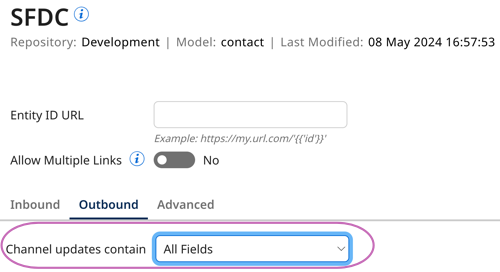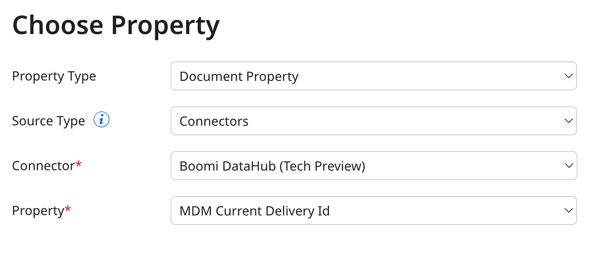Fetch Channel Updates operation
The Fetch Channel Updates operation retrieves batches of requests to create, update, or delete records in a specified channel for a deployed model. Each batch contains entities up to the repository's 200 entity outbound limit. With automatic acknowledgement set, the operation retrieves batches until there are no pending requests in the channel. The update requests are returned in XML format.
You can use this operation to send golden record data from Boomi DataHub to an accepting source for data synchronization. The operation aligns with the Fetch Channel Updates operation in the Repository API. In the legacy connector this operation was titled Query.
For example, you can create an integration that sends contacts from the Boomi DataHub connector, routes the record based on its op attribute (DELETE, CREATE, UPDATE, etc) to the correct Salesforce operation, and maps the contact record to the contact record in Salesforce. Salesforce receives a batch of contact record updates.
Operation behavior
When you set channel updates to include all fields, the fetched updates show the latest version of the records. Even if many updates happen between fetches, you'll receive the latest version of updates.

When you set channels to only include changed fields in record updates, you'll receive field updates since the last batch of delivered updates.
Automatic and manual acknowledgement
By default, the connector automatically acknowledges that you've received a previous batch of updates after it delivers the next batch in the same channel. Boomi DataHub can also automatically confirm the batch as received if you manually delete the updates. Boomi DataHub does not resend batches that it automatically acknowledged as received.
You can set your integration to manually acknowledge that you received a batch of updates. Read MDM Current Delivery Id property for more information on manual acknowledgement.
Prerequisites
You must have the following:
- A Hub repository
- A deployed model in the repository
- Active golden records in the deployed model
- Pending update requests in the channel for a source that accepts channel updates
- Open source channel in the deployed model's Source tab (green dot)
- A deployed Boomi basic runtime to run connector operations (Integration > Manage > Runtime Management)
Setting up the Fetch Channel Updates operation
- In the connector, select Fetch Channel Updates in the Action drop-down.
- Click the plus icon in the Operation field to create a new operation.
- Click Import Operation.
- Select the basic runtime you want to use to run your integration. The basic runtime must be online.
- Ensure the connection you created to the repository is selected in the Connection field.
- Optional: In Source, enter the source ID, which acts as a filter to help you select the deployed model name. You can find the source ID on the Sources page in Hub.
- Optional: In Filter, enter a regex as a filter to help you select the deployed model name.
- Click Next.
- Select the deployed model name.
- Click Next.
- Click Finish. The import operation creates a response profile. You can use this response profile to map data in a Map step within your integration.
- In Source, enter the source ID for the source receiving the batch of updates.
- Optional: Select Manually Acknowledge if you want Boomi DataHub to confirm the delivery of the previous batch before fetching the next update request batch. You can use this setting with the connector's Dynamic Operation Properties tab to automatically enter the latest MDM Current Delivery ID. Document properties are an option if the Boomi DataHub connector is not a start step. Read step 17 to learn more about Dynamic Operation Properties.
- Optional: Fetch Single Update Request - Retrieves a single update request when using manual acknowledgement. This setting ensures that only one update request is delivered for each fetch request instead of the outbound limit.
- Optional: In Max Updates enter a number to limit the amount of update requests retrieved and acknowledged. This setting is only relevant with automatic acknowledgement set. When this field is left blank, the operation continues to fetch updates until there are no pending update requests.
- Optional: The MDM Current Delivery Id field is used to manually acknowledge a batch as received. You can leave this field blank and populate this field using the Dynamic Operation Properties tab in the connector. Your integration checks if this property is populated and if there is a value here, it acknowledges the batch as received. It then proceeds with the next batch. If this property is empty and Manually Acknowledge is set, only the first batch is returned.
- Click Save and Close.
- Optional: The Dynamic Operation Properties tab lets you set the tracked property MDM Current Delivery Id with the delivery ID from the previous fetch. This setting is relevant when using manual acknowledgement. Read MDM Current Delivery Id property to learn more.
- Optional: Select Return Application Error Responses if you want the operation to continue when there is an application error. Processing continues and passes the error to the next component processed as the connection output. When the checkbox is clear, the process stops and reports the error in Process Reporting.
- Click OK.
- Click Save.
Fetch Response example
<batch id="2" fmt="FULL" src-"SF">
<contact op="UPDATE" grid="61bf3e7e-fa64-4bf9-12gh-12abcd245ef6" ts="05-17-2024T16:40:48.000+0000">
<id>SF-1</id>
<name>Quinn</name>
<city>Miami</city>
<country>USA</country>
</contact>
<batch>
The connector uses administrator privileges to authenticate. Therefore, masked field values are unmasked in responses.
| Element | Definition |
|---|---|
| id | batch ID. Also known as the MDM Current Delivery ID. The ID can be used to acknowledge a batch as delivered. |
| fmt | channel type that specifies the amount of data sent. FULL indicates that the channel is set to send all fields in an update request, including unchanged values. DIFF indicates the channel is set to send only changed field values. |
| src | source ID of the destination source. |
| grid | grid ID. |
| ts | timestamp for the associated golden record update. |
| op | the operation performed in Hub on the record. Available values:
|
| id | source entity Id. This is an entity's child element. |
MDM Current Delivery Id property
The MDM Current Delivery Id is a tracked property that is returned in the documents with each successful fetch.
When you select Manually Acknowledge, you can use one of the following options in your process:
-
Use the delivery ID returned from a previous fetch to populate the MDM Current Delivery Id field in the next fetch.
-
Set the Dynamic Operation Property tab in the connector to MDM Current Delivery Id to receive the delivery ID from the previous fetch. This is only available when the connector is not a start step. You can select Add Dynamic Operation Property > Document Property and set the Document Property to the Boomi DataHub connector and the MDM Current Delivery Id property.

-
Use the Acknowledge Previously Fetched Channel Updates API. You can make a request using the HTTP connector and the delivery ID in your process.
When the operation is set to automatically acknowledge, this property is empty.
